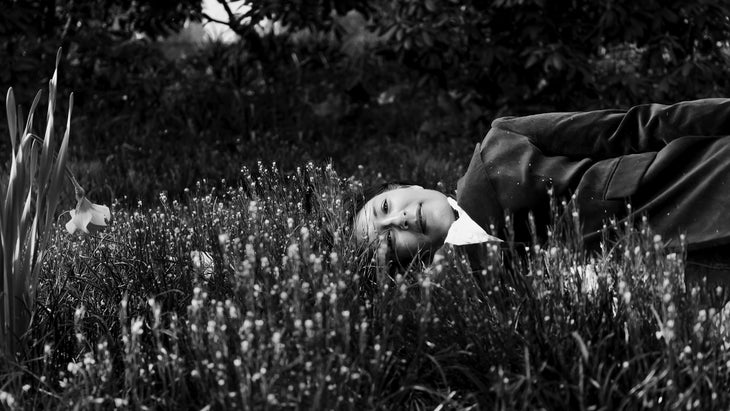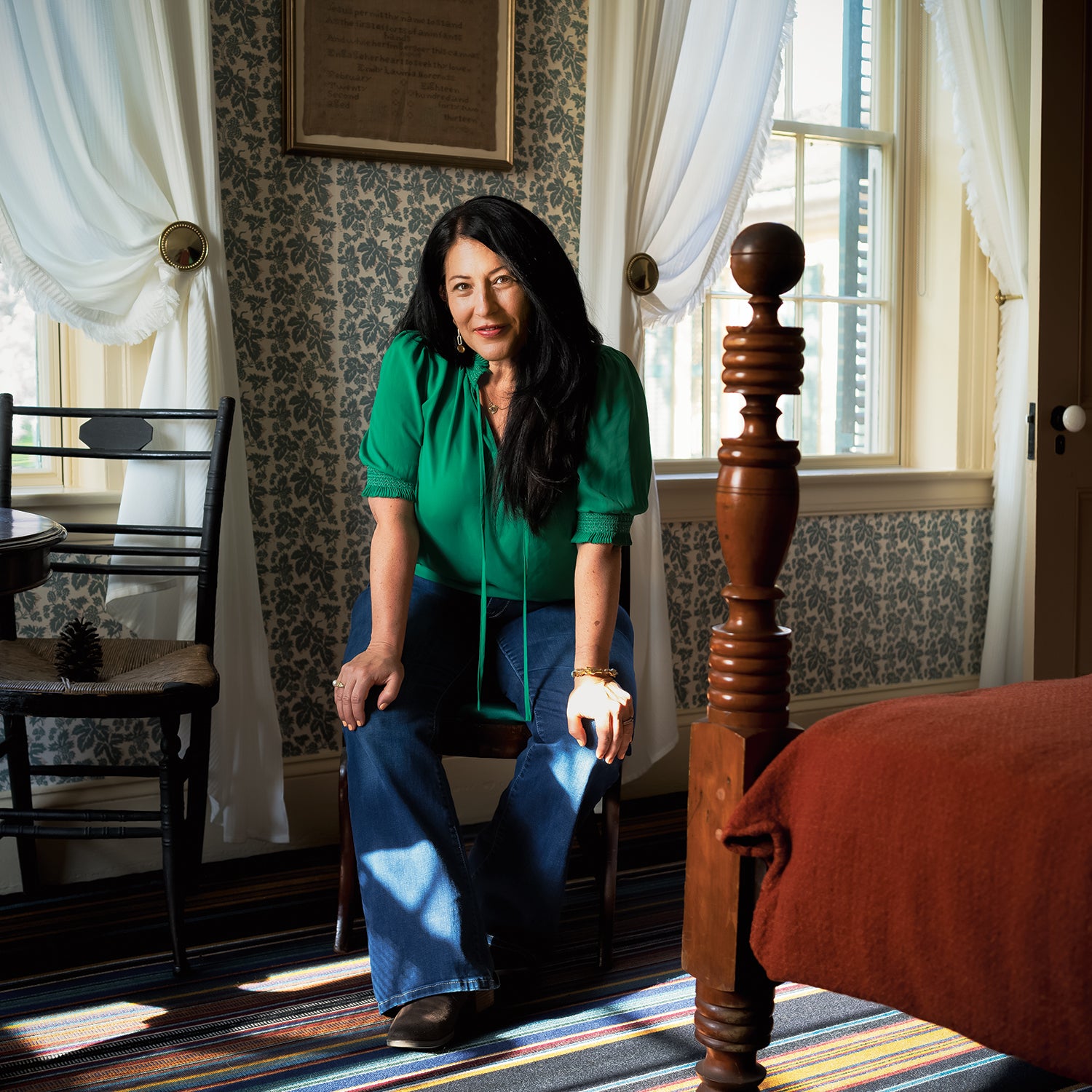If Ada Limón were left to her own devices for the day, she would rise, hug her husband and her dog, write a poem, and read a poem. Then she’d spend the rest of her waking hours learning the names of things—flowers, trees, insects, clouds. “There’s a beauty to naming, to learning the name, to identifying,” she tells me one morning in March. Once, while looking up the term for part of a magnolia tree, she discovered that the species is primarily pollinated by beetles, which are older than bees, and that its early ancestors lived alongside the dinosaurs.
“When people ask, ‘How do you keep finding things to write about?’ I’m like, ‘How do you not?’” she says. “How could you not wonder in awe at the magnolia tree and think of it existing among the dinosaurs? It’s endless.”
It has been a while since Limón, 48, had an entire day to spend as she pleased. In July 2022, she was named the 24th poet laureate of the United States—the first Latina to be awarded the seat—by the Library of Congress. Since 2006, she has published , and currently she’s working on four book projects in addition to touring and promoting the projects she’s created in connection with her new post. In February, she was honored as one of Time magazine’s 12 Women of the Year. Even scheduling interviews with her involves coordinating with three people—an impressive contingent for a poet.
But Limón graciously takes my video calls from her home office in Lexington, Kentucky. Her 13-year-old pug snores next to her, she’s surrounded by hundreds of books, and she’s intentionally calm and engaged: “Before every reading, every event, every vacation, I put my hand on my heart and say to myself, Be present and enjoy this.”
Yet as much as she lives in the moment, Limón wants to encourage change, and that requires forethought. During their one-to-four-year tenure, each poet laureate in recent history has developed a project to bring the literary form to those who might not otherwise encounter it. Limón wanted her project to involve nature. “My first thought was, What if we flew planes over deforested land, with poems written on seed packets, and worked to reseed and replant places harmed by wildfires?” She figured that the good people at the Library of Congress would ask her to dream a little smaller.
Instead, she opted to focus on the accidental encounter: How could she create opportunities for people to stumble upon a poem while in nature? The result is a dispersed exhibit of picnic tables engraved with poems by a variety of modern writers selected by Limón. The initiative is being rolled out at seven national parks this summer. At Mount Rainier, in Washington State, the late poet A. R. Ammons’s work “Uppermost” will accompany a view of the 14,411-foot peak from the park’s popular Paradise area:
The top / grain on the peak / weighs next / to nothing and, / sustained / by a mountain, /
has no burden, / but nearly / ready to float, / exposed / to summit wind, / it endures / the rigors of having / no further / figure to complete / and a / blank sky / to guide its dreaming
Why national parks? According to Limón, these are places of “intentional nature,” destinations you might seek out in pursuit of an altered state. Maybe you’re looking to quiet your mind. Maybe you’re chasing an experience of wonder. Maybe you just felt restless and cooped up.
A pitfall for many motivated to get outdoors, however, can be missing the forest for the trees. Limón cites hiking to an objective, like a summit or a lake, as an example: “You’re supposed to be at ease, at peace, and in awe, but then you’re thinking, I have to get to this place.” It’s only by slowing down—to take a closer look at a flower, say—that the wonder begins to reveal itself.
“The connection between poetry and nature is that they both give us a moment to recognize what we’re going through. They give us space. They give us breath. They return us to ourselves.”

Like nature, poetry invites the mind to wander and take a break from its preoccupations. “Poetry is a place that holds so much mystery. It holds a space for the unknown and for the messy interior of the mind,” she says. She also hopes that people will use it to ponder language—but also the limits of language. “Poetry makes room for that. So often we stand in a forest and think, Oh, there are no words, and that’s enough.”
Each picnic table includes a prompt: “What would you say in response to the landscape around you?” Limón also asked 50 poets that question and compiled their responses into an anthology of nature poems titled , published by Milkweed Editions in April. It’s the second half of her project and aims to offer diverse reflections on the many ways we engage with the earth, including “daily nature, urban nature, ourselves as nature,” Limón says.
Limón grew up in Sonoma County, California, a child of artistic, outdoorsy parents. (Her mother’s paintings adorn the covers of her poetry collections.) In school, the syllabus included field trips to the ocean, and she constantly learned about the plants and animals that surrounded her home. Words held a deep fascination. She graduated from the University of Washington with a major in drama, but a trusted professor suggested a second degree in poetry, which led to an MFA at New York University. That morphed into a career doing marketing for national magazines, an arrangement that subsidized her real passion. After juggling the two pursuits for a decade—and publishing three poetry collections—at the age of 34 she quit her job to write full-time. Accolades and awards followed, as well as a , a university teaching position, and a MacArthur “genius” grant.
Although Limón has been in Kentucky for more than a decade, memories of her time in New York continue to find their way into her work. Initially, the wilderness of her childhood felt distant from the city. Then she discovered the East River, the city’s winged and four-legged inhabitants, the plant life, the weather, “the bright ginkgo, with its foul smell, smashed on the sidewalks—all of that is part of nature,” she says.
“Nature is observing us as well. It’s reciprocal,” says Limón. “Noticing that kind of relationship, feeling seen by the world, not only makes you a better steward, it also makes you less lonely.”
You Are Here provides a more expansive view of the outdoors, in which the neighborhood gingko is of equal importance to the high peaks. Limón considered including archival works but decided against it. “The nature poem has changed,” she says. “You can’t have a nature poem extracted from the emotional impact of climate change. Everything is tied up in what we’ve done. Making room for complicated grief is just as important as making room for the beauty, the awe, and the wonder.”
Instead of perpetuating the old-school style she describes as “a white man standing on a mountain having an epiphany,” she wanted work with a broader array of perspectives. “You see a colonial, idealistic taming of the land in those [older] poems, or that nature exists just for the poet to observe it. What hubris, when in reality nature is observing us as well. It’s reciprocal.”
The experience of being witnessed is a recurring theme in Limón’s own work. “A Name,” the first poem in her collection , published in 2018, reads:
When Eve walked among / the animals and named them— / nightingale, red-shouldered hawk, / fiddler crab, fallow deer— / I wonder if she ever wanted / them to speak back, looked into / their wide wonderful eyes and / whispered, Name me, name me.
Limón is masterful at simple, surprising shifts in perspective. When you give equal weight to the human and animal points of view—and perhaps throw a few plants into the mix as well—the world becomes a friendlier place. She’s an avid birder, and her half-acre backyard contains several feeders. When she forgets to fill them, the birds make it known. “They come by like: Hey, what’s going on? Noticing that kind of relationship, feeling seen by the world, not only makes you a better steward, it also makes you less lonely.”
Beginning this summer, Limón will visit each of the seven parks selected to receive a picnic table as part of the project. She tells me that she can’t wait to visit the redwoods of Northern California, where Chicano poet Francisco X. Alarcón’s “Never Alone” will be featured. The short piece addresses a phenomenon similar to what Limón feels when the birds seek her out, a kindred companionship.
Always / this caressing / Wind / this Earth / whispering / to our feet / this boundless / desire / of being / grass / tree / corazón
Limón is looking forward to her own personal shift in perspective amid the world’s tallest trees. “I’m obsessed with feeling small,” she says. “It’s very good for my brain. I can turn myself into an all-encompassing, looming force in my own life, but when I’m in the redwoods, I feel like the smallest speck.”


